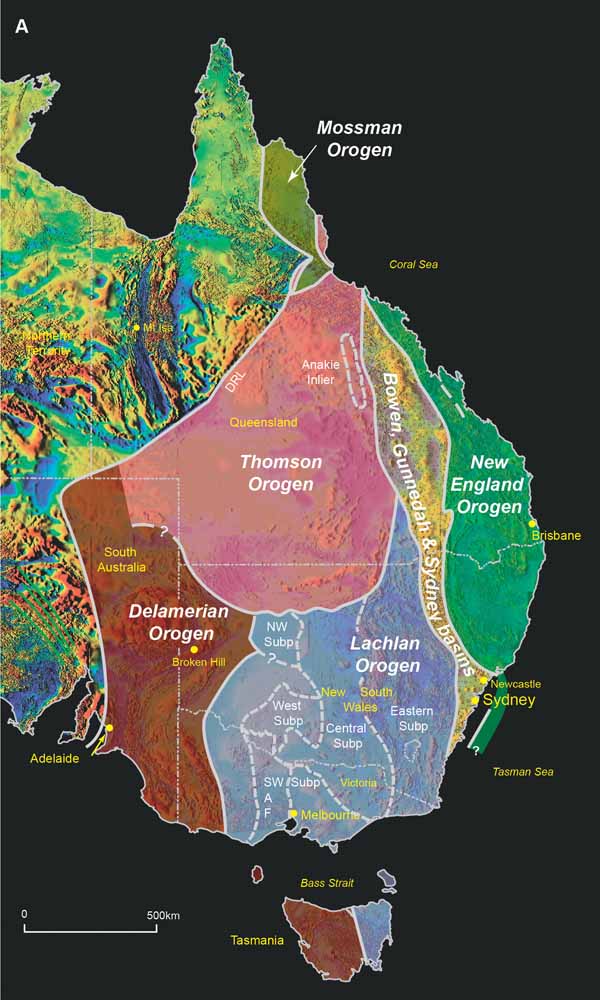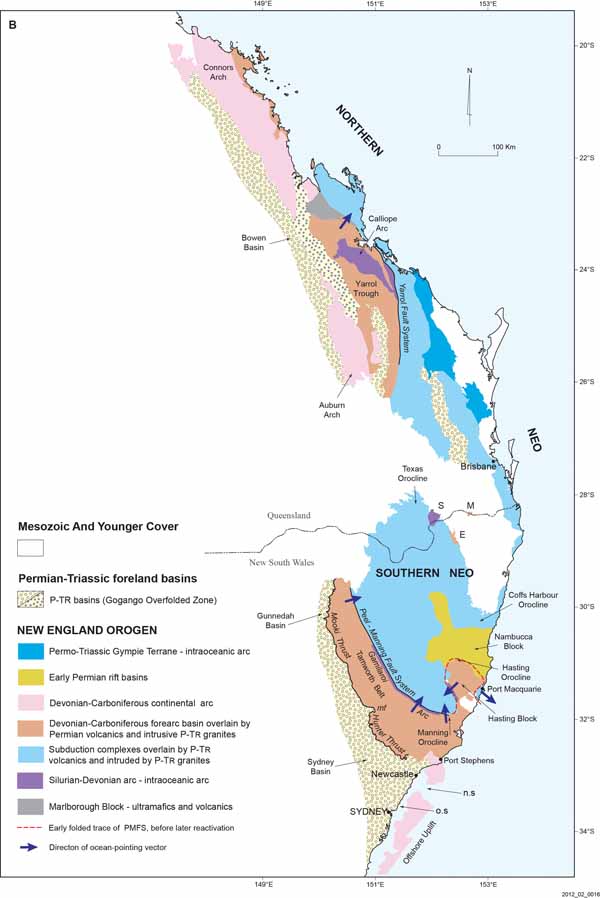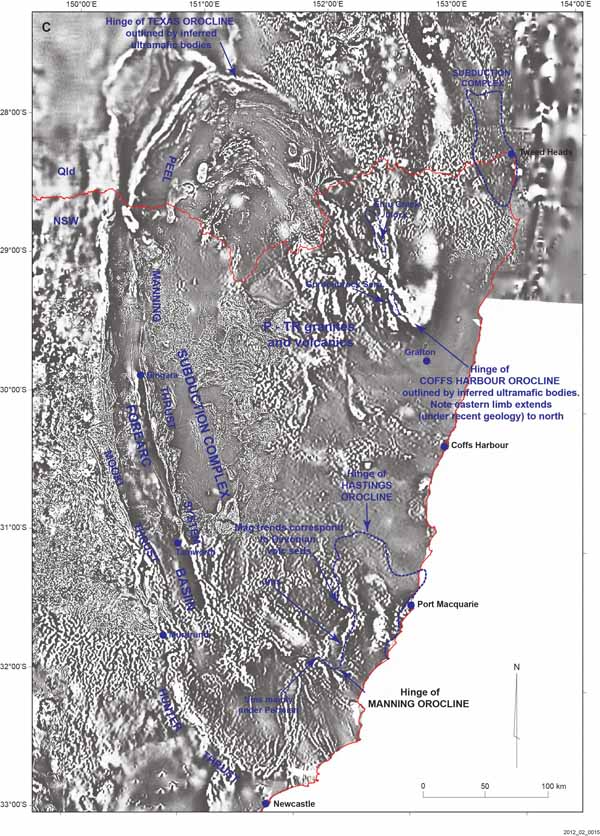Introduction
The most obvious feature of the southern part of the New England Orogen of eastern Australia (Fig. 1a) is the presence of a double orocline pair outlined most simply by the boundary between the forearc basin and the coeval subduction complex (Figs. 1b, c). These oroclines, with wavelengths and amplitudes of tens of kilometres, explain the great width of subduction complexes in the centre of the orogen, and the presence of forearc basin lithologies on the east as well as the west of these duplicated subduction complexes (Fig. 1b). All four oroclinal hinges are clearly outlined by grey scale 1VD aeromagnetic imagery that highlights folding of ultramafic rocks in the major Peel-Manning Fault System (and extensions under cover to the north) that separates the forearc basin from the subduction complex (Fig. 1c).
Figure 1. Location of the New England Orogen

A. Geology of eastern Australia showing location of New England Orogen as the most outboard element of the Tasmanides. AF=Avoca fault; DRL=Diamantina river lineament.

B. Simplified geology of the New England Orogen. The frontal thrusts of the southern New England Orogen, the Mooki Thrust in the north and the Hunter Thrust in the south are separated by the Murrurundi fault (mf). Note: i) linear geometry in the northern part of the orogen compared to oroclinal folding in the southern part; ii) the presence of inferred arc rocks offshore (Offshore Uplift) separated from onland Sydney basin by offshore syncline (os), and from expanded volcanic centre at Port Stephens by Newcastle syncline (ns); iii) outcrops of forearc basin rocks east of subduction complex at E (Emu Creek block) and M (Mt Barney); iv) presence of subduction complex rocks east of forearc basin rocks at E and M above, and at Port Macquarie, east of forearc basin rocks in the Hastings Block; v) presence of Calliope arc rocks on eastern side of Texas orocline at S (Silverwood block); vi) thin sliver of Silurian-Devonian Gamilaroi arc along Peel-Manning Fault System; v) the Gogango Overfolded Zone only occurs in the Queensland part of the New England Orogen. The onland part of the figure is from Champion et al. (2009).

C. Greyscale total magnetic intensity first vertical derivative (1VD) map over the southern New England Orogen. Ultramafic rocks along the forearc basin/subduction complex boundary clearly highlight the northern oroclinal folds, and less clearly the southern Manning Orocline. Abbreviations: mag = magnetic; volc = volcanic; ums = ultramafic rocks.
The northern oroclinal pair comprises the Texas orocline in the northwest and the Coffs Harbour orocline in the southeast (Flood and Fergusson 1982; Korsch and Harrington 1987) (Figs. 1b, c). The pair has a clockwise sense of rotation. The Coffs Harbour orocline is outlined by subvertically folded strata in Devonian–Carboniferous subduction complexes (Korsch 1993); the Texas orocline by steeply (70-80º) plunging folded strata in subduction complexes and by moderately (~30º) plunging folds in early Permian strata (Lennox and Flood 1997; Li et al. 2012). The southern orocline pair, comprising the Manning orocline in the west and the Hastings orocline in the east, is more controversial and several workers (eg. Lennox and Roberts, 1988; Offler and Foster 2008; Lennox and Offler 2009; Lennox and Offler 2010) have questioned its existence. However, both megafolds are also visible, albeit not so clearly, in aeromagnetic data, with the greyscale 1VD image highlighting discontinuous rotation of ultramafic and volcanic rocks around the southern Manning Orocline (Fig. 1c).These data suggest the southern oroclines have an anticlockwise sense of rotation. As will be discussed below, these fold hinges are more complex than in the northern pair.
The aim of this paper is to present evidence for this southern oroclinal pair, consisting of the southwestern Manning orocline and the northern Hastings orocline, to analyse their significance in a New England Orogen tectonic context, and then to propose a new model for oroclinal formation that does not involve strike-slip movement on any inferred master fault. The first part of the paper presents map-scale evidence for the rotation of stratigraphy around these two folds. Their geometry is then discussed, with an emphasis on a new interpretation of the Hastings Block presented in Appendix A.